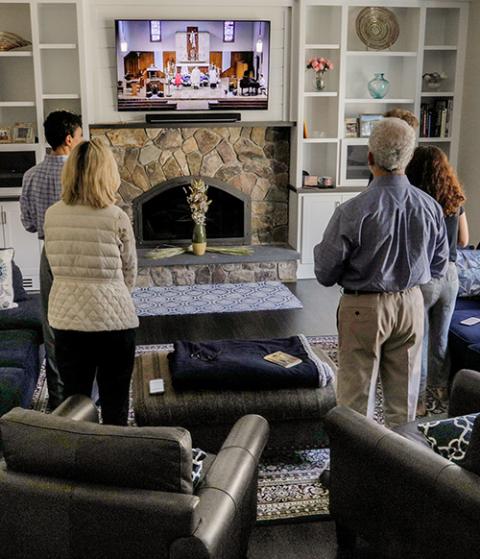
Mass is livestreamed on Facebook by Fr. Tom Kovatch at St. Charles Borromeo Catholic Church in Bloomington, Indiana, March 24, 2020, during the COVID-19 pandemic. (CNS/Katie Rutter)
Every Sunday, whoever is welcoming the gathered at my parish also welcomes those "joining us online," before inviting us to stand for the processional hymn. Sometimes, I imagine that these folks are actually in the choir loft, where the camera and streaming laptop actually are. I can't see them, but for most of Mass, I also can't see the people in the pews behind me. But we're together.
I do see folks during Communion, of course, but I have to admit that I tend to only notice the person right in front of me, making sure I don't step on their heels or do anything else ridiculous as we head up to receive the Body. This is the climax of the liturgy, and there is something beautiful about the entire activity, the church suddenly becoming a flurry of activity when we had been so dutifully in our pews for the rest of the time.
Masses during the pandemic gave us an important — albeit stressful — moment to reflect on the liturgy. In one of the most poignant moments in the early days of the crisis, Pope Francis offered an urbi et orbi blessing from an empty St. Peter's Square. Anyone watching that moment — Catholic or not, religious or not — could feel the yawning emptiness of the square. For many, it managed to capture the distance between us all, physical and emotional.
Many of our Protestant sibling traditions adapted easily to online alternatives. Indeed, many were already streaming their services before the pandemic forced them to.

The Lando family of Carlisle, Massachusetts, participates in St. Mary's Catholic Church's streamed Easter Mass April 12, 2020. (CNS/Reuters/Brian Snyder)
We Catholics, on the other hand, found ourselves gathered for Mass in alien spaces like Facebook Live, YouTube and Zoom. Ironically, our relative unfamiliarity with these spaces meant radical variation in technical choices. Some pastors and parish professionals adapted easily and made good choices. Others did their best.
But it's 2024. That was then; this is now. Most of the masks are gone (for better or worse) and the doors of churches are open. Isn't it time for us to close the laptops, unplug the cameras, and end the meeting?
Jesuit Fr. Thomas Reese thinks so. As a theologian, I understand what motivates dramatic responses to digital technology in the context of the Mass. Folks like Reese are worried about the sacraments, specifically our physical interaction with them.
The physical elements of the sacraments are not just important — they are the whole point. Indeed, they are the center of a sacramental economy that informs the Catholic imagination to see the whole created world as infused with the grace of God.
But there are at least three strong arguments for continuing to stream the Mass and other liturgical moments.
First, we can uphold the importance of consuming the eucharistic elements while at the same time making liturgical space for folks who are not consuming them. We already do this. One can think of a variety of circumstances in which a person would be present for the liturgy but not consume the Eucharist: a child who has not made her first Communion; a friend or family member who is not Catholic coming to Mass with their loved one; a person who discerns that they are not in a state to receive.
By arguing that physical consumption of the Eucharist is the only reason to be present at Mass, we undermine these legitimate ways of being gathered. It is possible to maintain that the ideal situation is a fully communed gathering, but we already know that at every Mass this is not the reality, and that it is perfectly fine.
Advertisement
Second, there is a group of folks for whom Mass online has widened their experience of the church, namely what I would call being the "church on the sidelines." Televised Mass has been around for a while, and there is an analogy here, of course. But with nearly every parish having the ability and willingness to stream, interested people are now able to experience a much wider version of the church. Televised Masses are not particularly diverse.
Diversity here need not be about liturgical difference. By diversity, I mean the simple fact of being exposed to different parishes. The universality of the church holds us all together but our individual communities — with all their quirks and beauty — hold us close.
Here, I want to make a plea for the legitimate space of the sidelines. There are a million reasons why someone might be on the sidelines — personal, political, physical or spiritual. Online Masses may not be our ideal liturgical encounter, but it remains an important way in which a person can remain somewhat connected to the church to which they may not — for whatever reason — feel totally connected.
There is as yet no evidence telling us that folks are choosing online Mass over Mass in the church building. What we do know is that there is a growing number of unaffiliated and disaffiliated people in the United States. The data also show that these folks aren't necessarily atheists; many of them are still searching.
Perhaps it's just because it's Easter season, but I can't help but feel like leaving the streams open reflects a deep hope that we still have something to offer the church on the sidelines.
Lastly and most importantly, any call to end streaming the Mass must take a hard look at the way in which this will disproportionately affect people with disabilities or other realities that are preventing them from joining us at the eucharistic table in the liturgically prescribed way.
In general, I think we should resist turning the pandemic into a parable from which we glean morals or lessons. But if we learned anything, it should have been empathy with folks for whom isolation and distancing is not a few months but their persistent reality.
Admittedly, the church has made liturgical and theological space for these folks with practices like taking the Eucharist to them after Mass. But we should be doing everything we can to acknowledge that we are not whole at Mass without them, and that we should do whatever we can to bring them into the assembly, including making use of the technology at our disposal.
A few practical caveats, however: The details of streaming the Mass need the same degree of attention as our other liturgical choices. We should strive to make the online experience of the Mass as intentional as possible. This means adopting or rejecting technologies based on our careful consideration of their appropriateness for our liturgical purposes. These are not simply tools, because they are not neutral: They carry the values and implications of our culture, and we must negotiate their employment in our sacred contexts with care.
So let there be streams — and let them reflect our hope in a broken world and our commitment to building the kingdom.








